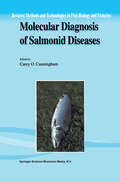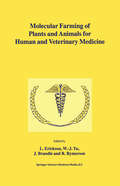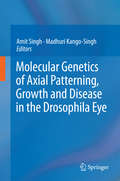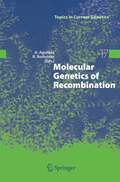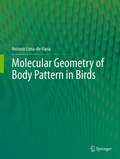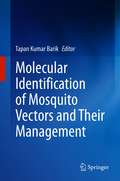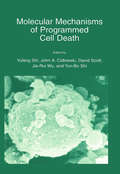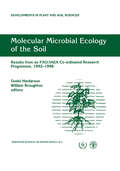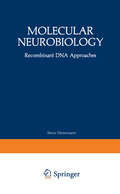- Table View
- List View
Molecular Detection of Animal Viral Pathogens
by Dongyou LiuMolecular Detection of Animal Viral Pathogens presents expert summaries on state-of-the-art diagnostic approaches for major animal viral pathogens, with a particular emphasis on identification and differentiation at the molecular level. Written by specialists in related research areas, each chapter provides a concise overview of an individual virus
Molecular Diagnosis of Salmonid Diseases (Reviews: Methods and Technologies in Fish Biology and Fisheries #3)
by Carey O. CunninghamReviews: Methods and Technology in Fish Biology and Fisheries published by Kluwer Academic Publishers is a book series dedicated to the publication of information on advanced, forward-looking methodologies, technologies, or perspectives in fish and fisheries. This series is especially dedicated to relevant topics addressing global, international concern in fish and fisheries. Humans continue to challenge our environments with new technologies and technological applications. The dynamic creativity of our own species often tends to place the greatest burden on our supporting ecosystems. This is especially true for aquatic networks of creeks, lakes, rivers and ocean environments. We also frequently use our conceptual powers to balance conflicting requirements and demands on nature and continue to develop new approaches and tools to provide sustainable resources as well as conserve what we hold most dear on local and global scales. This book series will provide a window into the developing dynamic among humans, aquatic ecosystems (both freshwater and marine), and the organisms that inhabit aquatic environments. There are many reasons to doubt the increasing social and economic value technology has gained over the last two centuries. Science and technology represent stages in human development. I agree with Ernst Mayer when he said in Toward a New Philosophy of Biology (1988) that "endeavors to solve all scientific problems by pure logic and refined measurements are unproductive, if not totally irrelevant.
Molecular Ecology and Conservation Genetics of Neotropical Mammals
by Maximiliano Nardelli Juan Ignacio TúnezAlthough all living beings modify their environment, human beings have acquired the ability to do so on a superlative space-time scale. As a result of industrialization and the use of new technologies, the anthropogenic impact has been increasing in the last centuries, causing reductions in the sizes or the extinction of numerous wild populations. In this sense, from the field of conservation genetics, various efforts have been made in recent decades to provide new knowledge that contributes to the conservation of populations, species, and habitats. In this book, we summarize the concrete contributions of researchers to the conservation of the Neotropical mammals using Molecular Ecology techniques.The book is divided into three major sections. The first section provides an up-to-date review of the conservation status of Neotropical mammals, the applications of the molecular markers in its conservation, and the use of non-invasive and forensic genetic techniques. The second and third sections present, respectively, a series of case studies in various species or taxonomic groups of Neotropical mammals.
Molecular Electronics: Biosensors and Biocomputers
by F. T. HongThe dream of developing a biocomputer should not be dismissed as a sheer fantasy. Although there is naturally some doubt as to whether it is possible to design a computer using carbon-based components as in living organisms, instead of silicon-based components as in existing computers, the fact that an average brain often outperforms the most sophisticated computer in terms of the complexity of tasks, if not in terms of speed, is a living testimony to this possibility. The remaining question is to what extent a biocomputer can mimic a living organism and whether it is possible to design and fabri cate such a biocomputer within the foreseeable future. This volume does not attempt to provide immediate and exact answers to these questions but instead attempts to provide a vision and a progress report of the initial efforts. This volume is mainly a collection of papers presented at the Symposium on Molecular Electronics - Biosensors and Biocomputers, sponsored by the Divi sion of Biotechnology, Health and Environment of the Fine Particle Society, held from July 19-22, 1989 at the Society's 19th Annual Meeting in Santa Clara, California. Also included are articles contributed by those who planned to attend the conference but were unable to do so. The emergence of the field of molecular electronics is largely the consequence of one person's crusade, that of Forrest L. Carter.
The Molecular Epidemiology of Human Viruses
by Thomas LeitnerAdvances in DNA sequencing and phylogenetic inference have created powerful methods to investigate many dangerous human viruses. The Molecular Epidemiology Of Viruses provides a comprehensive introduction to the use of genetic methods in molecular epidemiology and in-depth examples of analyses from many viruses. This book is of interest to researchers in the fields of infectious disease, virology, microbiology, evolutionary biology, epidemiology and molecular biology as well as anyone interested in tracking the spread of disease.
Molecular Evolution: Evidence for Monophyly of Metazoa (Progress in Molecular and Subcellular Biology #19)
by Werner E. G.MüllerThis volume concentrates on the origin of multicellular animals, Metazoa. Until now, no unequivocal phylogeny has been produced. Therefore, the questions remain: Did Metazoa evolve from the Protozoa only once, or several times? Is the origin of animals monophyletic or polyphyletic? Especially the relationships between the existing lower metazoan phyla, particularly the Porifera (sponges) are uncertain. Based on sequence data of genes typical for multicellularity it is demonstrated that all Metazoa, including Porifera, should be placed into the kingdom Animalia together with the Eumetazoa. Therefore it is most likely that all animals are of monophyletic origin.
Molecular Farming of Plants and Animals for Human and Veterinary Medicine
by L. Erickson W. J. Yu J. Brandle R. RymersonMolecular farming has been hailed as the "third wave" of genetically-modified organisms produced through biotechnology for the bio-based economy of the future. Unlike products of the first wave, such as herbicide resistant crop plants, which were perceived to benefit only the farmers who used them and the agrochemical companies who developed them, products of molecular farming are designed specifically for the benefit of the consumer. Such products could be purified from food or non-food organisms for a range of applications in industry, as well as animal and human health. Alternatively, the products of this technology could be consumed more directly in some edible format, such as milk, eggs, fruits or vegetables. There is a rapidly-growing interest Qn the part of the public as well as in the medical community in the role food plays in health, especially in the immunophysiological impact of food over and above the role of basic nutrition.
Molecular Genetics: 4. wissenschaftliche Konferenz der Gesellschaft Deutscher Naturforscher und Ärzte Berlin 1967
by Heinz G. Wittmann Heinz SchusterA small informal symposium on "Molecular Genetics" was organized by us on behalf of the "Gesellschaft Deutscher Naturforscher und Arzte" and took place in Berlin in October 1967. There were about 40 partici pants from Europe and the United States. Molecular Genetics represents today an extraordinarily comprehensive research field. Therefore the organizers of the symposium had the choice either of limiting the meeting to a particular topic or of covering a wider selection of current problems. The latter alternative was chosen. The fields of research of the participants covered the broad range of scientific problems in which molecular genetics is nowadays involved: Genetic code; chemistry and biosynthesis of proteins; mutation, modification and reactivation of nucleic acids; biochemistry of regulation; comple mentation; structure; replication and function of viruses, etc. The meeting took place in the Hotel Schweizerhof where the partici pants were also accommodated. This permitted close contact between the participants outside of the official program and allowed informal discussions, which started during the meetings, to be continued after wards. Owing to the informal nature of these discussions, only a part of them could be included in this book. Berlin, September 1968 H. G. WITTMANN H. SCHUSTER Contents List of Participants . . . . . . . . . . .... VII I. Structure and Function of Ribosomes; Complementation Complementation and Dominance Relationsship between Protein Subunits. By J. R. S. FINCHAM. . . . . . . . . . . . . . . Ribosomal Proteins of E. coli and Yeast. By E. KALTSCHMIDT, V. RUDLOFF, G. STOFFLER, A. CHERSI, M. DZIONARA, D. DOl\IIER, and H. G. WITTMANN . . . . . . . . . . . . . . .. . . 5 .
Molecular Genetics of Axial Patterning, Growth and Disease in Drosophila Eye
by Amit Singh Madhuri Kango-SinghDrosophila melanogaster (fruit fly) is a highly versatile model with a genetic legacy of more than a century. It provides powerful genetic, cellular, biochemical and molecular biology tools to address many questions extending from basic biology to human diseases. One of the most important questions in biology is how a multi-cellular organism develops from a single-celled embryo. The discovery of the genes responsible for pattern formation has helped refine this question and has led to other questions, such as the role of various genetic and cell biological pathways in regulating the process of pattern formation and growth during organogenesis. The Drosophila eye model has been extensively used to study molecular genetic mechanisms involved in patterning and growth. Since the genetic machinery involved in the Drosophila eye is similar to humans, it has been used to model human diseases and homology to eyes in other taxa. This updated second edition covers current progress in the study of molecular genetic mechanisms of pattern formation, mutations in axial patterning, genetic regulation of growth, and more using the Drosophila eye as a model.
Molecular Genetics of Axial Patterning, Growth and Disease in the Drosophila Eye
by Amit Singh and Madhuri Kango-SinghUndoubtedly, Drosophila melanogaster, fruit fly, has proved to be one of the most popular invertebrate model organisms, and the work horse for modern day biologists. Drosophila, a highly versatile model with a genetic legacy of more than a century, provides powerful genetic, cellular, biochemical and molecular biology tools to address many questions extending from basic biology to human diseases. One of the most important questions in biology focuses on how does a multi-cellular organism develop from a single-celled embryo. The discovery of the genes responsible for pattern formation has helped refine this question, and led to other questions, such as the role of various genetics and cell biological pathways in regulating the crucial process of pattern formation and growth during organogenesis. Drosophila eye model has been extensively used to study molecular genetic mechanisms involved in patterning and growth. Since the genetic machinery involved in the Drosophila eye is similar to humans, it has been used to model human diseases and homology to eyes in other taxa. This book will discuss molecular genetic mechanisms of pattern formation, mutations in axial patterning, Genetic regulation of growth in Drosophila eye, and more. There have been no titles in the past ten years covering this topic, thus an update is urgently needed.
Molecular Genetics of Recombination (Topics in Current Genetics #17)
by Andrés Aguilera Rodney RothsteinThis work offers a fascinating insight into a crucial genetic process. Recombination is, quite simply, one of the most important topics in contemporary biology. This book is a totally comprehensive treatment of the subject, summarizing all existing views on the topic and at the same time putting them into context. It provides in-depth and up-to-date analysis of the chapter topics, and has been written by international experts in the field.
Molecular Geometry of Body Pattern in Birds
by Antonio Lima-de-FariaAfter having read this book you will never see birds in the same way again.The unexpected patterns displayed by a bird’s body have been seen as bizarre events that demanded little attention or were described as ‘amazing curiosities’.None of these surprising features seem to be fortuitous. They appear to be an integral part of a rigid order and a coherent geometry, which is directed by simple gene interactions and molecular cascades occurring at various cellular levels, and at different times, during the organism’s development.A novel geometry unfolds in front of your eyes, giving the body configurations another meaning.Lima-de-Faria is Professor Emeritus of Molecular Cytogenetics at Lund University, Lund, Sweden. This is his sixth book dealing with the molecular organization of the chromosome and its implications for the understanding of the mechanisms responsible for biological evolution.
Molecular Identification of Mosquito Vectors and Their Management
by Tapan Kumar BarikThis book summarizes the recent advancements in identifying the mosquito vectors and discusses various strategies for their control. The book describes various molecular taxonomic methods, including DNA barcoding and single nucleotide polymorphism-based machine learning approach, which are used for the identification of mosquito vectors. It also presents the various mosquito control methods, namely, phytochemicals, Bacillus thuringiensis toxins, nanotechnology, biological control agents, and environmental management strategies. It also highlights the importance of various repellents that are used for protection from different kinds of mosquito vectors. Finally, the book offers a comprehensive yet representative description of challenges associated with mosquito vector-borne diseases. The book is a useful resource for medical entomologists, health workers, and researchers working in mosquito-control and vector-borne diseases.
Molecular Insect Science
by H. H. Hagedorn J. G. Hildebrand M. G. Kidwell J. H. LawThis volume contains the scientific papers and abstracts of posters presented at the International Symposium on Molecular Insect Science held in Tucson, Arizona, October 22-27, 1989. This meeting was organized by the Center for Insect Science at the University of Arizona in response to the growing need for a forum dedicated to the impact of modern biology on insect science. While scientific studies of a few insects, notably Drosophila melanogaster, have always had a central role in the development of biology, it is only recently that tools have become available to extend these studies to other insects, including those having economic and medical importance. The Tucson meeting was evidence of how far we have come in extending modern biological tools to the study of insects. It is also evident from the contents of this book that the study of insects is making an increasingly important contribution to the advancement of biology generally. Given the large impact of insects on human life, such a development has considerable importance for human welfare, and of the welfare of the ecosystem as a whole. It should be noted that several of the participants who presented posters were invited to prepare full length papers to ensure that the book covered the major areas of insect science. The financial support of the National Science Foundation and the Monsanto Corporation is gratefully acknowledged. Thanks are also due to Sharon Richards for her dedicated work on the manuscripts. Henry H.
Molecular Markers, Natural History and Evolution
by J. C. AviseMolecular approaches have opened new windows on a host of ecological and evolutionary disciplines, ranging from population genetics and behavioral ecology to conservation biology and systematics. Molecular Markers, Natural History and Evolution summarizes the multi-faceted discoveries about organisms in nature that have stemmed from analyses of genetic markers provided by polymorphic proteins and DNAs. The first part of the book introduces rationales for the use of molecular markers, provides a history of molecular phylogenetics, and describes a wide variety of laboratory methods and interpretative tools in the field. The second and major portion of the book provides a cornucopia of biological applications for molecular markers, organized along a scale from micro-evolutionary topics (such as forensics, parentage, kinship, population structure, and intra-specific phylogeny) to macro-evolutionary themes (including species relationships and the deeper phylogenetic structure in the tree of life). Unlike most prior books in molecular evolution, the focus is on organismal natural history and evolution, with the macromolecules being the means rather than the ends of scientific inquiry. Written as an intellectual stimulus for the advanced undergraduate, graduate student, or the practicing biologist desiring a wellspring of research ideas at the interface of molecular and organismal biology, this book presents material in a manner that is both technically straightforward, yet rich with concepts and with empirical examples from the world of nature.
Molecular Markers of Brain Tumor Cells: Implications for Diagnosis, Prognosis and Anti-Neoplastic Biological Therapy
by Bela Bodey Stuart E. Siegel Hans E. KaiserChildhood brain tumors are a diverse group of diseases characterized by the abnormal growth of tissue contained within the skull. Other than leukemia and lymphoma, brain tumors are the most common type of neoplasms that occur in children. The leading cause of death from childhood neoplasms among persons up to 19 years is brain tumors. As such, this book is a review of the most recent molecular biological research concerning brain tumors with references and comparisons to a variety of neoplastic disorders. The book then uses this information to foreshadow the direction that future anti-neoplastic therapies will take. Because of the wide spectrum of the objectives of the book, any individual involved in cancer research will greatly benefit from the work. Histopathologists, neuropathologists, clinical and research oncologists, and medical students will find this book to be an invaluable resource as a reference guide. Patients and their families will also find the book useful as it offers a comprehensive update on new, non-classical therapeutic modality options and contains a detailed description and analysis of brain tumors. Such an endeavor has yet to be undertaken by any other book and may prove to be the most comprehensive book on brain tumors thus far.
Molecular Mechanisms for Repair of DNA: Part A (Basic Life Sciences #5)
by Philip HanawaltAn "age" has passed in the 40 years since we first observed recovery from radiation damage in irradiated bacteria. During the early 1930s, we had been discussing the possibility of rapid changes after radiation exposure with Farring ton Daniels, Benjamin Duggar, John Curtis, and others at the University of Wisconsin. After working with living cells, we had concluded that organisms receiving massive insults must have a wide variety of repair mechanisms available for restoration of at least some of the essential properties of the cell. The problem was how to fmd and identify these recovery phenomena. At that time I was working on a problem considered to be of great importance-the existence of the so-called mitogenetic rays. Several hundred articles and a score of books had already appeared dealing with mitogenetic rays, a type of radiation that was thought to exist in the shorter ultraviolet region. Our search for mitogenetic rays necessitated the design of experiments of greatest sensitivity for the detection of ultraviolet. It was vital that conditions be kept as constant as possible during exposure. All the work was done at icewater temperature (3-5°C) during and after exposure. We knew that light was an important factor for cell recovery, so all our experiments were done in dim light, with the plated-out cells being covered with dark cloth. Our statements on the effect of visible light stimulated Kelner to search for "photoreactivation' (as it was later called).
Molecular Mechanisms of Exocytosis (Molecular Biology Intelligence Unit)
by Romano RegazziThis book examines the role of key components in the exocytotic process, not only in neuronal and endocrine cells but in a variety of other relevant cell systems. So far, because of the large number of components involved, understanding of the molecular basis of exocytosis has remained the privilege of a relatively small group of specialists. The book collects up-to-date reviews from the forefront of this fascinating and rapidly evolving field.
Molecular Mechanisms of Neurotransmitter Release (Contemporary Neuroscience)
by Zhao-Wen WangNeurons in the nervous system organize into complex networks and their functions are precisely controlled. The most important means for neurons to communicate with each other is transmission through chemical synapses, where the release of neurotransmitters by the presynaptic nerve terminal of one neuron influences the function of a second neuron. Since the discovery of chemical neurotransmission by Otto Loewi in the 1920s, great progress has been made in our understanding of mol- ular mechanisms of neurotransmitter release. The last decade has seen an explosion of knowledge in this field. The aim of Molecular Mechanisms of Neurotransmitter Release is to provide up-to-date, in-depth coverage of essentially all major mole- lar mechanisms of neurotransmitter release. The contributors have made great efforts to write concisely but with sufficient background information, and to use figures/diagrams to present clearly key concepts or experiments. It is hoped that this book may serve as a learning tool for neuroscience students, a solid reference for neuroscientists, and a source of knowledge for people who have a general interest in neuroscience. I was fortunate to be able to gather contributions from a group of outstanding scientists. I thank them for their efforts. In particular, I want to thank Dr. Erik Jorgensen who offered valuable suggestions about the book in addition to contrib- ing an excellent chapter. I thank US National Science Foundation and National Institute of Health for their supports.
Molecular Mechanisms of Neurotransmitter Release (Advances in Neurobiology #33)
by Zhao-Wen WangNeurons communicate with each other by releasing neurotransmitters. This book provides comprehensive coverage of the molecular mechanisms involved in neurotransmitter release. The topics covered in the book range from the architecture and cytomatrix proteins of presynaptic sites, to the modes of synaptic vesicle exocytosis (full-collapse and kiss-and-run), and from the key molecules mediating synaptic vesicle fusion (SNAREs) to those that closely interact with them (UNC-13/Munc13, UNC-18/Munc18, tomosyn, and complexins). The book also delves into the calcium sensors of synaptic vesicle fusion (synaptotagmins and Doc2s), the sources of calcium that trigger synaptic exocytosis (voltage-gated calcium channels and ryanodine receptors), and the regulation of neurotransmitter release by potassium channels, cell adhesion molecules, lipids, aryl hydrocarbon receptor-interacting protein (AIP), presenilins, and calstabins. To aid in understanding and illustrate key concepts, the book includes sufficient background information and a wealth of illustrations and diagrams. The new edition includes major updates to previous chapters, as well as several new chapters that reflect the recent advances in the field. Comprehensive and cutting-edge, Molecular Mechanisms of Neurotransmitter Release, 2nd edition, is a valuable learning resource for neuroscience students and a solid reference for neuroscientists.
Molecular Mechanisms of Programmed Cell Death
by Yun-BoShi Jia-RuiWu DavidScott John A. Cidlowski YufangShiThe 2002 Nobel Prize in Physiology or Medicine was awarded to Sydney Brenner, H. Robert Horvitz, and John E. Sulston for their seminal discoveries concerning "genetic regulation of organ development and programmed cell death." This clearly marked the prime importance of understanding the molecular mechanisms controlling cell death. The 1 st International Symposium on Programmed Cell Death was held in the Shanghai Science Center of the Chinese Academy of Sciences on September 8-12, 1996. A number of key issues in apoptosis were discussed at the meeting, and progress in major areas of apopto sis research was summarized by expert participants at the meeting and published by Plenum Publishing Corporation as a book entitled Programmed Cell Death. In the last six years, we have witnessed a real explosion in our knowledge on how cells undergo apoptosis, thereby participating in various developmental and pathophysiological processes. At this ever exciting time, we organized the 2nd International Symposium on Programmed Cell Death.
Molecular Methods for Microbial Identification and Typing
by K.J. Towner A. CockayneThe accurate identification and typing of microbes is essential for workers active in all fields of microbiology. Many examples of modern molecular methods have been concealed in scientific and medical literature but this introductory text considers the possible applications of such methods and compares their advantages and disadvantages.
Molecular Methods in Ecology
by Allan BakerThe incorporation of molecular methods in ecological research has added an exciting new dimension to conventional studies, and opened windows into previously intractable areas of research, at the interface between ecology and genetics. Using these new methods it has now become routine to use genetic markers to study ecological phenomena, from molecular sexing of individuals and parentage of offspring, through to population structure of species and phylogenetic relationships of taxa. These methods have stimulated an explosion of empirical and analytical developments in molecular ecology, which have in turn, increasingly attracted students and professional biologists eager to employ them in their studies. Molecular Methods in Ecology traces the development of molecular ecology by reviewing basic molecular biological techniques and earlier methods such as protein electrophoresis, DNA-DNA hybridisation, restriction analysis of DNA, and DNA fingerprinting. Later chapters review methods using newer classes of markers such as microsatellites, introns, MHC, SSRs and AFLP markers in plants and molecular sexing in animals. The strengths and limitations of methods are discussed and guidance is provided in selecting the most appropriate methods for particular problems in ecology. This book will provide both postgraduates and researchers with a guide to choosing and employing appropriate methodologies for successful research in the field of molecular ecology. Provides up-to-date summaries of the latest molecular approaches in this rapidly expanding field. Gives guidance on the appropriate choice of methods for particular problems in ecology, and their strengths and limitations. Provides brief laboratory protocols for each molecular method and summaries of software available for analysis of data in molecular ecology. Outlines examples of the latest research results from studies of both plants and animals, integrated within the framework of molecular ecology.
Molecular Microbial Ecology of the Soil: Results from an FAO/IAEA Co-ordinated Research Programme, 1992–1996 (Developments in Plant and Soil Sciences #83)
by Gudni G. Hardarson William J. BroughtonMolecular Neurobiology: Recombinant DNA Approaches (Current Topics in Neurobiology)
by Steve Heinemann James PatrickThis book is a collection of papers describing some of the first attempts to apply the techniques of recombinant DNA and molecular biology to studies of the nervous system. We believe this is an important new direction for brain research that will eventually lead to insights not pos sible with more traditional approaches. At first glance, the marriage of molecular biology to brain research seems an unlikely one because of the tremendous disparity in the histories of these two disciplines and the problems they face. Molecular biology is by nature a reductionist approach to biology. Molecular biologists have always tried to attack central questions in the most direct approach possible, usually in the most simple system available: a bacterium or a bacterial virus. Important experiments can usually be repeated quickly and cheaply, in many cases by the latest group of graduate students entering the field. The success of molecular biology has been so profound because the result of each important experiment has made the next critical question obvious, and usually answerable, in short order. Studies of the nervous system have a very different history. First, the human brain is what really interests us and it is the most complex structure that we know in biology. The central question is clear: How do we carry out higher functions such as learning and thinking? How ever, at present there is no widely accepted and testable theory of learn ing and no clear path to such a theory.

